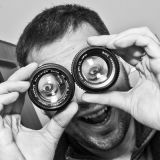- Forum
- Photography and Camera Forum
- Camera Manufacturers - by Brand
- Canon Camera Forum
- Help with Canon 7D
Help with Canon 7D
-
 Topic Author
Topic Author
- mimentophoto
- Newbie
- Follower: 1
-
Points:
0
Post #55070
I just recently upgraded to the 7D from my entry level Rebel XT. However, in my practice shoots, I've been really disappointed in the image sharpness--I was expecting the images to be crisp and clear, but they're not! Trying different things...anyone have any ideas?
Is it the lens? It's the kit lens 24-85mm. There are a few images I took that did seem crisp, but I can't figure out what was different. Focus, shutter speed, aperture were all fine.
Thanks!
-
 Topic Author
Topic Author
- mimentophoto
- Newbie
- Follower: 1
-
Points:
0
Post #55072
Just an example of an image from the 7D.
-
 Topic Author
Topic Author
- mimentophoto
- Newbie
- Follower: 1
-
Points:
0
-

- Henry Peach
- Apprentice
-
- I currently use a 5DII or Sony Nex-3 most of the time.
- Followers: 50
- Posts: 2925
-
Points:
16
Post #55641
-

- qualityresults
- Lone Wolf
-
- Canon 7D and a Canon XTI
- Followers: 8
- Posts: 150
-
Points:
20
Post #55718
1. which focus mode are you using, selective or all. (I use Selective Centre point)
2 what F-stop are you using....smaller number shorter focal distance. ( I try to stay around 8 on my Zoom lens and not fully wide open on my prime)
3. What ISO are you using. (I actually use 200 mostly)
4. What Shutter speed. (shutter speed with out OS, should be no less than the Lens length, i.e shooting at 85mm should have a shutter speed of 100 or better, but to stop movement a little higher hand held.)
But another thing, I have noticed that with the camera being substantially heavier camera shake is the biggest issue I am faced with.
It does take quite a bit of getting used to but practice will teach what adjustments you need to make.
Lastly, in the manual, Have a look for the lens adjustment feature under custom functions, it gives directions on how to adjust the camera for focus on individual lenses.
Post #55948
some other things i would like to add
one other thing is that the 7D is much more demanding on the resolving power of lenses and steadiness if you are looking at 100% crop as this would be enlarged much more than the rebel.
Therefore camera shake and lens softness is going to be much more obvious.
Here is what I suggest to check where the issue is:
mount the camera on a table/tripod/something very sturdy,
then use liveview 10x and manual focus to shot something.
This will be you baseline for that lens and what it can resolve.
now defocus the lens, and turn off live view and use AF to take a shot of the same image. Now compare the two to see if there is any difference.
This should tell if there is any AF issues.
it would be best to do this one a sunny, none windy day or with flash to rule out camera shake.
also I have heard (not personally seen) that spot AF can sometimes play up and not focus on anything. so try using single point AF for this experiment.
Hope this helps.
-
 Topic Author
Topic Author
- mimentophoto
- Newbie
- Follower: 1
-
Points:
0
Post #57329
1. What is selective centre point focus? I use auto focus that I select manually--is that what you mean?
2. I definitely open up my aperture, since I do mostly portraiture. Why would that affect the focus?
Thanks again!
-

- qualityresults
- Lone Wolf
-
- Canon 7D and a Canon XTI
- Followers: 8
- Posts: 150
-
Points:
20
Post #57499
Opening the aperture to say 1.8 on a nifty fifty, means that the focal distance will be very short i.e the closest and furthest point that will remain in focus. ( I have seen pictures where the only thing in focus on an expensive 50mm 1.4 lens is the nose and nostrils, why because it was wide open and that was the total area that remained in focus at 1.4)
For most Zoom lenses the sharpest images are obtained at between f8 and f11.
Most digital cameras have the ability to step up or down in 1/2 or 1/3 steps.
In the old film world steps would be in full so 1.0 1.4 2 2.8 4 5.6 8 11 16 22 32 45 64 90 128 these are full stops. you will notice that a lot of the fstops available on your digital camera are missing. this is because of the 1/2 or 1/3 step scale used.
I recommend using the 1/2 stop scale on your camera when you have a choice. 1.0 1.2 1.4 1.7 2 2.4 2.8 3.3 4 4.8 5.6 6.7 8 9.5 11 13 16 19 22
As you can see it is closest to the real film world, I use full stops whenever possible as this is what I am used to.
ISO is the same: some cameras don't work very well when the ISO steps are not in alignment with the base for the camera. Or in other words not all cameras are created equal. I believe the native ISO for the 7D is 200 and multiples of 200 work the best and any splits ie iso 500 actually cause more noise because it is not native step or if the camera native ISO is 150 then 300 would be the next step then 450 but 400 would cause noise because it is digitally corrected for. You would have to test your camera on each ISO to see the difference and find the native base ISO. With all other settings being the same.
And really this is no different than in the film days when you used to push Film, trying to push film half a step was harder than a full step.....I know I am talking in archaeic terms but the ideology has not really changed that much. (just faster)
Photography is science as well as an art. but half the fun is learning your camera, the half is using what you have learned.
There are some major differences between the XT and the 7D and they take some getting used to, but the benefits are worth it, once you learn how your camera works best.
-

- Yasko
- Photography Hooked
-
- Canon 5D, Canon 30D, Olympus tough P&S
- Followers: 47
- Posts: 805
-
Points:
30
Post #58217
One thing to remember with the 7D, it's expanding your captured sensor data to 18MP, which is a lot of interpolation. Think of it like taking a sharpie marker and writing your name on a balloon. The more you blow up the balloon, the fuzzier your name gets right? This is analogous to what crop frame sensors such as the 7D can do when making high MP files. It's expanding the image beyond what the sensor can resolve, and applying algorithms to reduce the resulting softness.
That being said, you still shouldn't be getting extrememely soft images when viewed at 100 percent. If you are, you could have a bad copy of the kit lens that came with your 7D. It can happen.
Here's what I'd do to test it:
1. You know your XT produces satisfactorily sharp images, so put the 24-85 lens on the XT body, set aperature to f8.0, set to 50mm, set on a tripod, and take some test shots of something. Check the test shot at 100 percent for tack sharpness. If non of your shots are sharp using auto focus even on the XT, your lens is bad, and it's back or front focusing. Do some careful focusing manually to verify this.
2. Let's say everything is sharp with the XT. You know the lens can't be at fault. Lets see if it's the 7D camera at fault. Now on the same tripod, same test subject, and same lens settings, shoot with the lens on the 7D. Reduce the resulting image to 3456 X 2304 pixels, so it matches the XT's resolution, and compare the two. They should have equal sharpness (the 7D may even have less noise because it's a newer dslr).
If the 7D image is not as sharp as the XT image, the camera could be bad. More likely you'll find a back or front focusing lens though. Let us know how it turns out.
- Forum
- Photography and Camera Forum
- Camera Manufacturers - by Brand
- Canon Camera Forum
- Help with Canon 7D
Latest Reviews
The Fujifilm XT5 is a 40MP mirrorless camera capable of 6.2K video at 30p. With those specs, it’s an ideal choice for photographers needing a camera to pull double duty for imaging and video.
The Canon EOS R100 is an entry-level mirrorless camera introduced in 2023. But just because it’s an entry-level camera doesn’t mean it’s a bare-bones camera. Find out why in this review!
Nikon’s retro-looking Nikon Zfc is anything but retro. Under its classic body is a host of features and amenities that make it a worthwhile compact mirrorless camera for 2024.
The Canon EOS R50 is one of the newest R-system cameras from Canon. Is it worth your money? Find out all the details you need to know in this comprehensive review.
Latest Articles
Newborn photography requires skill, the right gear, and a lot of patience. This beginner’s guide discusses critical topics that will help you be more prepared for before, during, and after the shoot.
To fill the frame means to expand the footprint of the subject in your shot. Get in close, zoom in, crop the image, or use other techniques to bring the subject to the forefront.
With these simple yet effective beginner photography tips, you can avoid some of the common mistakes beginners make and get improved results with your images.
Urban photography is a genre showcasing features in urban settings. You can photograph people, architecture, mass transit, and many other subjects. Learn how to do so in this guide!
The Nikon D850 might be an older DSLR, but it was ahead of its time when it debuted in 2017. That means it still has plenty of firepower to compete with today’s powerful mirrorless cameras.
The best beginner camera isn’t the same for everyone. That means having choice is of the utmost importance. In this guide, explore five excellent beginner camera options for 2024 and beyond.
Child portrait photography is a unique undertaking requiring special skills and talents to get the best results. Start mastering this photography niche with these essential tips!
The Fujifilm XT5 is a 40MP mirrorless camera capable of 6.2K video at 30p. With those specs, it’s an ideal choice for photographers needing a camera to pull double duty for imaging and video.
















